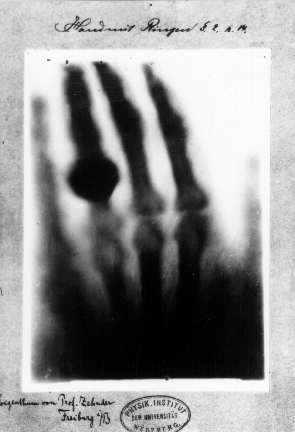Published on: 2023-11-05
Written by Nathan Pulver
- Cathode ray tubes, so hot right now
- Properties of this unknown ray
- Publishing and impact of the discovery
Cathode ray tubes, so hot right now
It’s the 1850s, cathode ray tubes are all the rage. We can shoot beams of electrons in a vaccuum and make things fluoresce. These beams are fun to play with, but outside the vaccumm tube, the electrons interact with air, and we cannot use them. Regardless, if you are a German physicist Wilhelm Roentgen, you are playing with the electron beams in cathode ray tubes (CRT), usually in the dark to observe the fluorescent phenomenon.On November 8th 1895, Roentgen noticed that a screen was fluorescing during one of his experiments with the CRTs. The fluorescent screen was much to far away to be the cause by the electron beam. Understanding the importance of this observation, he spent the next weeks investigating this phenomenon.
Properties of this unknown ray
As Roentgen saw from his initial experiments, this ray travels through glass (the CRT) and through air at least some distance. One experiment he tried was to see what, if any materials would stop this mysterious ray. With the same screen he saw fluorescing, he attempted to put a piece of lead in front of it to see if the emission would stop. As he brought this lead into position, he saw the shadow of his own skeleton. A few weeks later, he tried a similar experiment on his wife with photographic film. With that the first ever medical X-ray was taken.

Publishing and impact of the discovery
Eventually, he published his discovery in a paper titled, “On a new Kind of Rays” in December of the same year. What do you call some unknown ray? The mathematical minded might say a X-ray of course. The importance of this study was immediately recognized. He was awarded an honorary doctorate of medicine from the University of Wurzburg due to the profound impact on the medical field. I still wouldn’t want a physicist operating on me. Roentgen also won the Nobel Prize for his discovery in 1901. The discovery of X-rays would also directly lead to a flurry of related Nobel prizes, which we will discuss in another article.